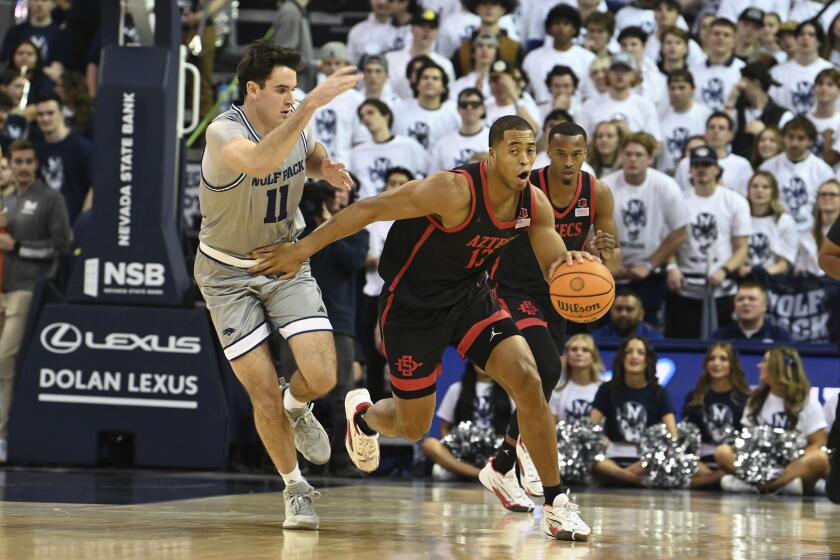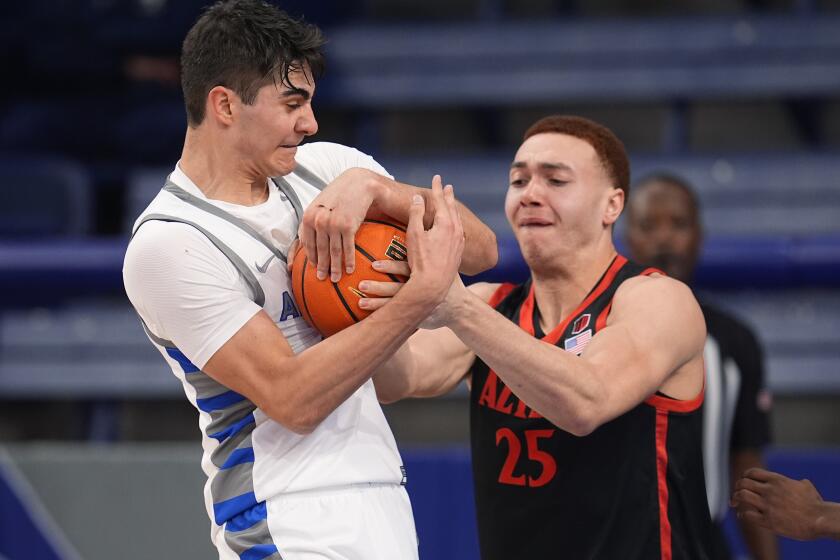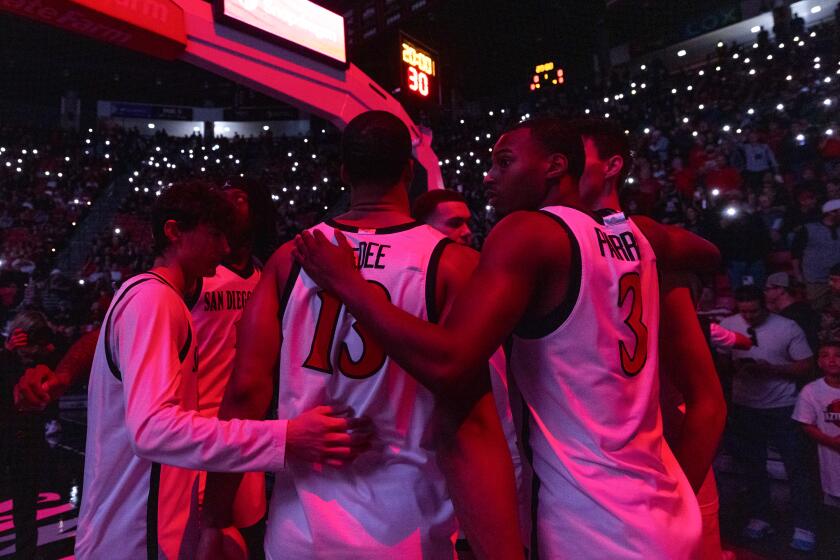3 thoughts: Nevada 70, No. 24 SDSU 66 (OT) ... metrics help, double teams and role players winning the game
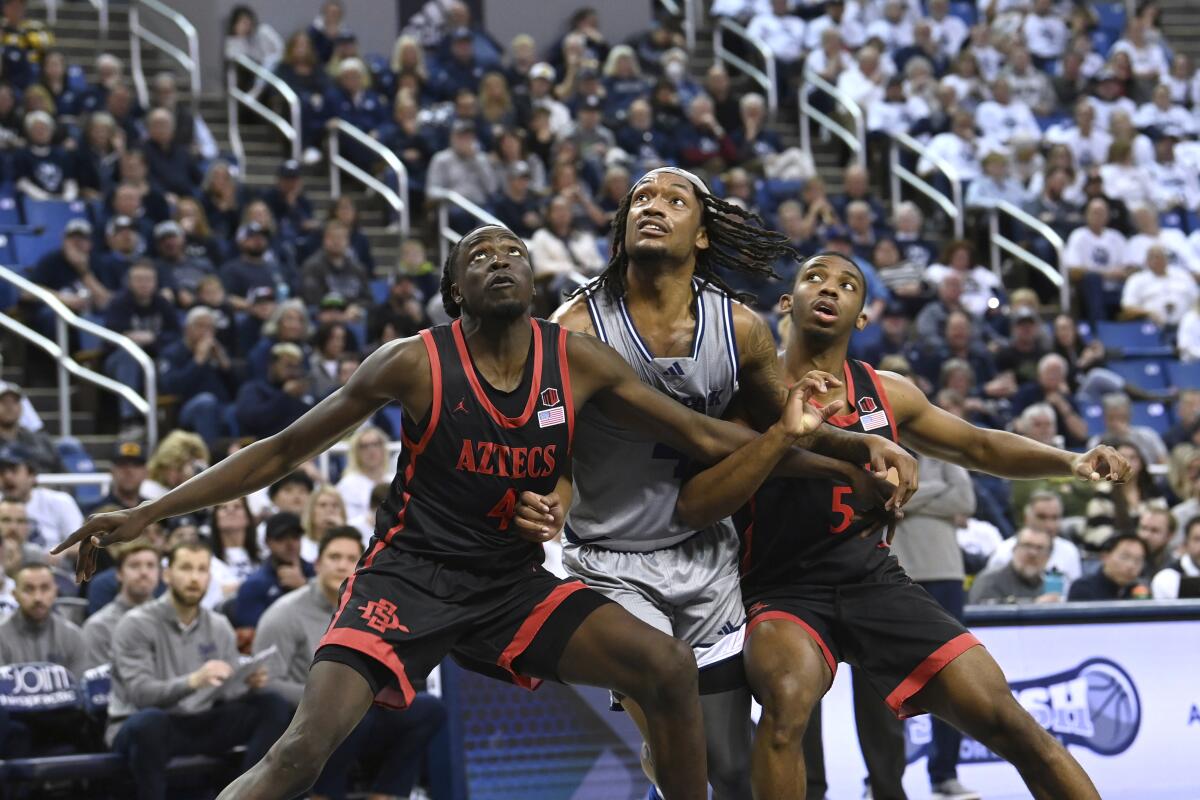
The Aztecs keep strong metrics thanks to their nonconference foes, the continued double teams on Jaedon LeDee and Nevada’s glue guys come up big
Three thoughts on San Diego State’s 70-66 loss at Nevada on Friday night:
1. A little help
The Aztecs started the day at 20 in the Kenpom metric … and ended it at 20.
They went from 21 in NET … to 21.
And that, despite their second worst game in offensive efficiency, despite shooting a season-low 3 of 19 behind the 3-point arc, despite 16 turnovers, despite collecting 14 fewer offensive rebounds than in the first meeting.
Despite being 4-4 in the past month.
One reason is the Mountain West has six teams in Kenpom’s top 50, so conference losses — particularly on the road — don’t ding you in the metrics. The Aztecs were actually projected to lose Friday against a Nevada team that is 46 in both Kenpom and NET.
But there’s another reason. The Aztecs need to send Valentine’s Day cards to BYU, Saint Mary’s, Cal, Grand Canyon and, yes, UCSD.
All of them have made at least 20-place jumps in Kenpom and NET since playing the Aztecs in the nonconference. Your metrics are based on what you do, but also on your strength of schedule. The rising tide of your nonconference opponents lifts your boat as well, even in the conference season.
BYU went from No. 35 in Kenpom when it beat the Aztecs in early November to No. 11 now. Saint Mary’s was No. 72 on Dec. 9, but the Gaels have won 11 straight in a weakened WCC, including 76-28 and 84-43 against Pacific, to climb to 25th. Cal went from 185th when the Aztecs beat them in overtime to 108th now. Grand Canyon, from No. 79 to 57.
The biggest jump and indirect bump, though, comes from UCSD. The Tritons were No. 247 in Kenpom and in the midst of a four-game losing streak when Jaedon LeDee’s buzzer-beater gave SDSU a 63-62 win at LionTree Arena on Dec. 1.
Since? They got as high as No. 100 after opening the Big West 9-1 before dropping to 110th with back-to-back road losses.
The Tritons were a Quad 4 game for SDSU at the time. It now counts as a Quad 2.
“This is a Quad 4 road game,” UCSD coach Eric Olen said that night when asked if SDSU should continue the series against the Tritons. “You guys can do the research. I can’t imagine there are a lot of top 20 Kenpom teams playing Quad 4 road games in the nonconference.
“My hope is that we continue to build and we get to a level where it makes sense for them to play. If we do our part and we build our program and we get to the top 100, top 75, top 120, I think the conversations can change at that point.”
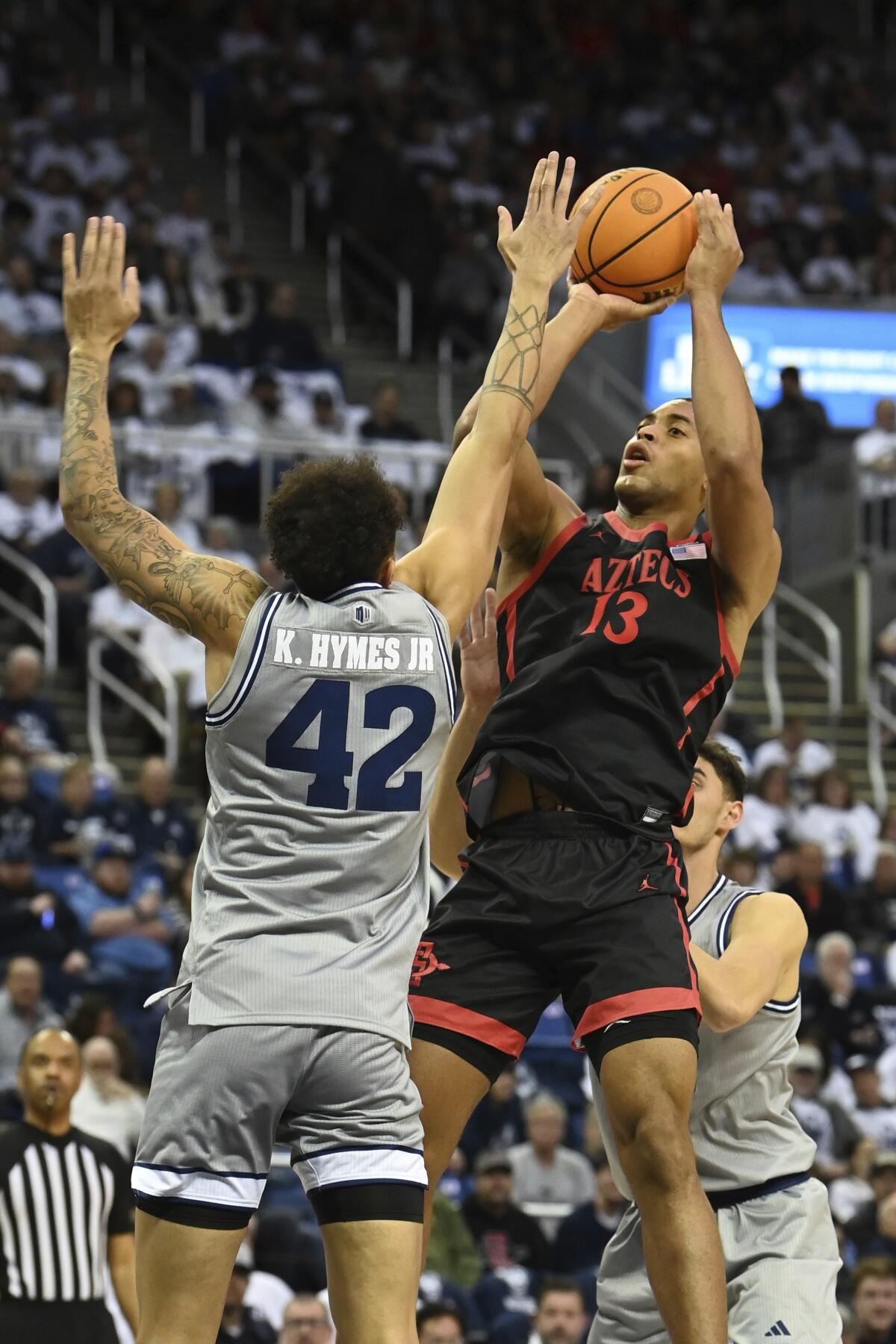
2. Double trouble
Teams didn’t double team Jaedon LeDee to start the season, and why would they? He was a career 5.1-points-per-game scorer.
But then he put up monster numbers and popped up on player of the year watch lists, and opposing teams figured they better make someone else beat them. So they started sending a second defender at him, usually after he caught the ball in the post and took a dribble.
Now? It’s an automatic double every time, especially in the low block.
Nevada took it to a new level Friday and provided another blueprint for SDSU’s future opponents. Instead of sending the double team from the opposite big, which for Utah State meant coming diagonally across the lane, the Wolf Pack doubled straight from the wing who entered the ball while the remaining on the three defenders rotated on the perimeter.
The downside of that strategy is the post player can see it coming and it requires crisp coordination on the rotation. The upside, in this case: The double comes quickly because the second defender has to run maybe 10 feet instead of 20 or 25.
“I have to slow down,” said LeDee, who finished with 20 points but a career-high seven turnovers. “It’s still something new to me. As soon as I catch it, they’re right there on me. They’re not waiting on the bounce, not waiting if I turn and face. They’re just right there.
“(Utah State) was big to big. This was right from the passer. I have a lot of room to improve. I have to get better.”
At 6-foot-9, LeDee isn’t tall enough to simply spin and throw over the trap. Instead, he took a retreat dribble and looked for an open teammate. He executed it perfectly early in the game, firing a cross-court pass to the opposite wing to Micah Parrish, who passed to the top to Lamont Butler, who drilled the open 3.
But the Aztecs would make only two other 3s over the next 42 minutes, and LeDee had several passes picked off or lost the ball trying to dribble out.
“He’s just a workhorse,” Nevada coach Steve Alford said. “He’s hard to play against. He drew 11 fouls and shot 14 free throws. So we made him earn his 20 points. I mean, 20 and seven (rebounds) and we played an extra five (minutes). We got him in foul trouble, seven turnovers.”
They’ll take that. Most teams will.
College basketball is a copycat game. Your move, Aztecs.
3. Role players
One of the beauties of basketball is that superstars don’t make all the winning plays. Role players matter, too.
They did Friday night, when the true heroes for Nevada were not Kenan Blackshear (22 points), Jarod Lucas (15) or Nick Davidson (14).
They were Tre Coleman, who missed 8 of 10 shots, and Daniel Foster, who averages 4.2 points per game and attempted exactly one shot in 32 minutes.
Coleman’s primary defensive assignment was Reese Waters, who went from making five 3s at Air Force on Tuesday to shooting 1 of 4 beyond the arc and finishing with seven points, five under his average.
“Defensively, off the charts,” Alford said. “He doesn’t get near the credit he should get not just in our league but in the West for how good a defender he is. He always guards well, even if he doesn’t have a good shooting night, and he didn’t.
“And he makes the biggest shot of the night.”
That came with 12 seconds left, tie game, overtime. Alford had called timeout and designed a play for Coleman to curl into the lane from the left side to clear space for the sharpshooting Lucas curling off a screen behind him.
But Blackshear, dribbling the ball at the top, didn’t wait to see if Lucas was open. He saw the 6-7 Coleman covered by 5-10 Darrion Trammell and fed him instead. Coleman backed down Trammell and easily lofted a short shot over him given the 9-inch, 40-pound disparity.
Coleman was 1 of 9 at the time. Didn’t matter.
“The play wasn’t written for Tre, actually,” Blackshear said. “I just said, ‘(Forget) the script,’ and threw it to Tre. I trust my teammates to make the play. He’s been big all year. He’s our glue.”
So has Foster. He had only two points but four assists and four offensive boards. One came with 44 seconds left in regulation, when he used his 8-inch, 40-pound advantage over Trammell to grab Blackshear’s miss, then fed Lucas, who would be fouled and make two free throws.
On their next possession, he poked away the rebound on the floor from Trammell. Davidson collected it and scored the tying basket with 8.5 seconds left.
At the other end, Foster was switched onto Trammell for SDSU’s final possessions of regulation and overtime. He tipped Trammell’s shot on the former, then forced an errant 3-point attempt on the latter that was lucky to clip the rim.
“I’m not going to invite you my film session here in a minute with the coaches, but if I did you’d see what we talk about all the time with Daniel,” Alford said. “For instance, Trammell is really good. Both times, in regulation and in overtime to end the game, that’s Daniel locking him up. In my opinion, he is one of the hardest guys to drive by. He’s got big, heavy, athletic legs. He gets in a stance, and he’s strong and physical.
“He just does so many good things for us that don’t show up on the stat sheet. Tremendous teammate.”
The kind of players and plays that — let’s just say it — SDSU is known for.
Sign up for U-T Sports daily newsletter
The latest Padres, Chargers and Aztecs headlines along with the other top San Diego sports stories every morning.
You may occasionally receive promotional content from the San Diego Union-Tribune.

